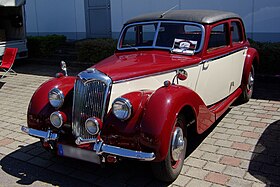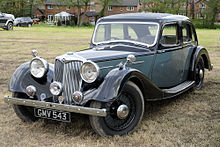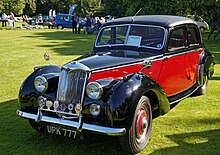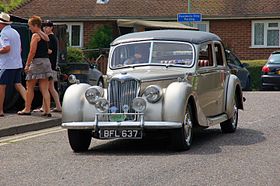Motor vehicle
| Riley RM Series | |
|---|---|
 1951 Riley RMA 1951 Riley RMA | |
| Overview | |
| Manufacturer | Riley Motors |
| Production | 1945–55 |
| Body and chassis | |
| Class | Executive car (E); compact executive car (D) |
| Body style |
|
| Layout | FR layout |
| Dimensions | |
| Wheelbase | 1.5 L cars – 112 in (2,845 mm) 2.5 L cars – 119 in (3,023 mm) |
| Length | 1.5 L cars – 179 in (4,547 mm) 2.5 L cars – 186 in (4,724 mm) |
| Width | 63 in (1,600 mm) |
| Height | 59 in (1,499 mm) |
| Chronology | |
| Predecessor |
|
| Successor | Riley Pathfinder |
The Riley RM is a series of executive cars and compact executive cars that were made by Riley Motors from 1945 until 1955. They were the last models developed independently by Riley before its parent company, Nuffield, merged with Austin to form BMC. The RM series was produced in Coventry until 1949, when production moved to the MG works at Abingdon. Until 1952, models were marketed as the Riley 1½ Litre and the Riley 2½ Litre. the term RM has been used retrospectively to encompass models produced before 1952.
There were four types of RM vehicles produced. All used Riley engines with four cylinders in-line, hemispherical combustion chambers and twin camshafts mounted high at the sides of the cylinder block.
The RMA was a large saloon, and was replaced by the RME. Both used a 1.5 L (1,496 cc) 12 hp (RAC Rating), developed before WWII.
The RMB was a longer car, and it was replaced by the RMF. Both cars used a larger engine, new in 1937, a 2.5 L 16 hp (RAC Rating) "Big Four".
The RMC and RMD were limited-production cars, an open 2 or 3-seater Roadster and a 4-seater drophead.
The Riley Pathfinder was the RMH, and was the last saloon to be built with the Riley Big Four engine.
Kestrel

The RM was inspired by Riley Motors' successful and stylish pre-war 1.5 and 2.5 Litre Kestrel saloons, but with a new chassis, which with its Riley "torsionic" independent front-wheel suspension incorporated the experience of the wartime years.
The RM series was a new design, because air raids on Coventry destroyed the patterns of dies for the pre-war models.
Riley RMA
Motor vehicle| Riley RMA | |
|---|---|
 1952 RMA 1952 RMA | |
| Overview | |
| Production | 1945–52 10,504 produced. |
| Body and chassis | |
| Body style | 4-door saloon |
| Powertrain | |
| Engine | 1.5 L Straight-4 as for 2.5-litre Big Four but bore 69mm by stroke 100mm and bhp 60 @5,300 rpm |
| Chronology | |
| Predecessor | Riley 12/4 and Riley 12 |
| Successor | Riley RME |
The RMA was the first post-war Riley. It was announced in August 1945 with the news it would become available in the autumn. It used the 1.5 L engine and was equipped with hydro-mechanical brakes and an independent suspension using torsion bars in front. The body frame (not to be confused with the chassis) was made of wood in the English tradition, and the car featured traditional styling. The car was capable of reaching 75 mph (121 km/h). The RMA was produced from 1945 until 1952 when it was replaced by the RME.
Riley RMB
Motor vehicle| Riley RMB | |
|---|---|
 | |
| Overview | |
| Production | 1946–52 6,900 produced |
| Body and chassis | |
| Body style | 4-door saloon |
| Powertrain | |
| Engine | 2.5 L Straight-4 |
| Dimensions | |
| Wheelbase | 119 in (3,023 mm) |
| Length | 186 in (4,724 mm) |
| Width | 63.5 in (1,613 mm) |
| Height | 59 in (1,499 mm) |
| Chronology | |
| Successor | Riley RMF |
The 2.5 L (2443 cc) RMB was a lengthened RMA launched a year later in 1946.
It used the 2.5 L (2443 cc) "Big Four" engine with twin SU carburettors, starting with 90 hp (67 kW) but increasing to 100 hp (75 kW) for 1948 with a 95 mph (153 km/h) top speed.
The wheelbase was 6.5 in (165 mm) longer and the overall length was a full 7 in (178 mm) longer. The RMB was replaced by the RMF for 1952.
The RMB 2½ Litre models have light blue bonnet and bootlid badges, differentiating them from the RMA 1½ Litre models which have dark blue badges.
A car tested by The Motor magazine in 1949 had a top speed of 90 mph (140 km/h) and could accelerate from 0–60 mph (97 km/h) in 16.8 seconds. A fuel consumption of 19.6 mpg‑imp (14.4 L/100 km; 16.3 mpg‑US) was recorded. The test car cost £1224 including taxes.
Riley RMC
Motor vehicle| Riley RMC | |
|---|---|
 1949 RMC 1949 RMC | |
| Overview | |
| Production | 1948–51 507 produced |
| Body and chassis | |
| Body style | 2-door open 2/3-seater |
| Powertrain | |
| Engine | 2.5 L Straight-4 |
The RMC (Roadster) was an open 2-door, single bench seat, 2/3-seater version of the RMB, with a large rear deck area and fold-flat windscreen. Announced in March 1948, it was delivered to Geneva just too late to be exhibited at the Geneva Motor Show. Primarily designed for the North American export market, it was normally built with left-hand drive, with the gear change lever on the steering column. The bonnet and radiator were lowered and the bonnet catches were arranged to be operated internally. Extra over-riders were fitted to the bumpers and the fuel tank was enlarged to 20 imp gal (91 L; 24 US gal).
Eighteen months later, in September 1949, Riley announced future production would include a small quota of cars with right-hand drive. Riley attributed that to a slight increase in the supply of steel.
Instead of side windows it was supplied with flexible celluloid-glazed side curtains with a hole for hand signals and, when deployed, flimsy synthetic roofing over a light metal frame. It shared that car's 2.5 L 100 hp (75 kW) engine, and could reach 100 mph (160 km/h).
Just over 500 were built from 1948 until 1951.

Both the back and front of the car bear a remarkable likeness to a 1934 Ford V8.
Riley RMD
Motor vehicle| Riley RMD | |
|---|---|
 1950 RMD 1950 RMD | |
| Overview | |
| Production | 1949–51 502 produced |
| Body and chassis | |
| Body style | 2-door cabriolet |
| Powertrain | |
| Engine | 2.5 L Straight-4 |
The RMD (drophead) is a traditional 2-door cabriolet, and was the last Riley cabriolet. It uses the same 2.5 L 100 hp (75 kW) engine as the RMB, on which it was based. Just over 500 were produced between 1949 and 1951.
This model was first displayed in October 1948 at London's Earls Court Motor Show.
Riley RME
Motor vehicle| Riley RME | |
|---|---|
 1953 RME 1953 RME | |
| Overview | |
| Production | 1952–55 3446 produced |
| Body and chassis | |
| Body style | 4-door saloon |
| Powertrain | |
| Engine | 1.5 L Straight-4 |
| Chronology | |
| Predecessor | Riley RMA |
| Successor | Riley One-Point-Five (1957) |
Launched in 1952, the RME was an improved RMA. It uses the same 1.5 L four-cylinder engine, and has a fully hydraulic braking system. The body has a larger rear window, with curved glass. To improve acceleration, the rear axle ratio was changed from 4.89:1 to 5.125:1.
When the 2.5 L (2443 cc) RMF ended production in October 1953, many details of the RME were revised. These included dispensing with running boards, and introducing entirely re-shaped front mudguards.
The RME was discontinued in 1955. It was succeeded in 1957 by the Riley One-Point-Five, which had been designed as a replacement for the Morris Minor, but never launched as such. This is a BMC design, unrelated to the RM series. It is much shorter than the RME, and was also badge-engineered as the Wolseley 1500, and in Australia as the Morris Major and Austin Lancer.
An RME tested by The Motor magazine in 1952 had a top speed of 75 mph (121 km/h) and could accelerate from 0 to 60 mph (97 km/h) in 29.5 seconds. A fuel consumption of 24.2 mpg‑imp (11.7 L/100 km; 20.2 mpg‑US) was recorded. The test car cost £1,339 including taxes.

Riley RMF
Motor vehicle| Riley RMF | |
|---|---|
 1953 RMF 1953 RMF | |
| Overview | |
| Production | 1952–53 1050 produced |
| Body and chassis | |
| Body style | 4-door saloon |
| Powertrain | |
| Engine | 2.5 L Straight-4 |
| Chronology | |
| Predecessor | Riley RMB |
| Successor | Riley Pathfinder |
The RMF replaced the RMB in 1952. It has the same 2.5 L Big Four engine, plus mechanical updates shared with the RME. RMF 2½ Litre models have light blue bonnet and boot-lid badges, whereas the RME 1½ Litre models have dark blue badges. In 1953 the RMH Riley Pathfinder replaced the RMF. This is the last car built with the Riley Big Four engine, and is thus considered to be the last "real" Riley by purists. It continued in production until 1957.
Riley 2½-litre Big Four engine
The Big Four engine is a four cylinder 2.5 litre engine rated at 16.07 h.p. under the British RAC formula. It was designed in a matter of months, under difficult financial conditions, and announced in the summer of 1937. It followed existing Riley practice, similar to their 1.5 litre engine, but with each cylinder completely surrounded by a water jacket. The fully counter-weighted and balanced crankshaft ran in three main bearings. Pre-war power output was at first 80 bhp (60 kW), then raised to 85 bhp (63 kW). In its final Riley Pathfinder form, it developed 110 bhp (82 kW), and was produced until the end of Riley Pathfinder production in February 1957.
Reciprocating internal combustion engine| Riley 2½-litre Big Four engine | |
|---|---|
| Overview | |
| Manufacturer | Riley Motors |
| Also called | Riley 16 h.p., Riley 16/4 |
| Production | 1937 to 1957 |
| Layout | |
| Configuration | straight four |
| Displacement | 2.443 L (149.1 cu in) |
| Cylinder bore | 80.5 mm (3.17 in) |
| Piston stroke | 120 mm (4.7 in) |
| Cylinder block material | cast iron, aluminium sump, alloy pistons |
| Cylinder head material | cast iron, hemispherical combustion chambers, spark plugs in centre between valve covers |
| Valvetrain | 90-degree angled overhead valves operated by twin high-lift camshafts moving rockers with short light stiff push-rods powered from the crankshaft by duplex roller chains |
| Compression ratio | 6.9 : 1 |
| Combustion | |
| Fuel system | Twin H4 SU carburettors mechanical petrol pump |
| Fuel type | petrol |
| Oil system | pressure fed from sump by submerged gear-type pump driven by skew gear from camshaft |
| Cooling system | water, thermostatically controlled flow, belt-driven water pump and radiator fan |
| Output | |
| Power output | 106 bhp @ 4,500 rpm Tax rating 16hp |
| Chronology | |
| Predecessor | none before 1937 |
| Successor | Riley RMH then BMC C-Series engine |
Bibliography
- Ramsey, John (1984). The Swapmeet and Toyfair Catalogue of British Diecast Model Toys. Swapmeet Toys and Models Ltd. p. 29. ISBN 978-0950931906.
- Sedgwick, Michael; Gillies, Mark (1989). A-Z of Cars 1945–1970. Motorbooks International. ISBN 1-870979-39-7.
- Taylor, James (1989). Riley RM-Series. Motor Racing Publications. ISBN 978-0947981365.
- Williams, John Price (2005). Riley: The Legendary RMs. Crowood Press. ISBN 978-1861267610.
References
- "British car brochures www.car-brochures.eu — Riley adverts". Archived from the original on 30 July 2023. Retrieved 20 September 2023.
- "The New Riley". The Manchester Guardian (1901-1959). Manchester. 28 November 1945. p. 6.
- "200,000 Cars in 12 months: Motor Trade's Plans Fifty percent for export". The Manchester Guardian (1901-1959). Manchester. p. 5.
- "Cars of To-Day". The Times. No. 47540. 24 November 1936. p. 12.
- "City Notes". The Times. No. 50229. 24 August 1945. p. 7.
- ^ "The Riley 2.5-litre Road Test". The Motor. 1949.
- ^ Malpas, Rob. "Frequently Asked Questions". rileyrob.co.uk.
- "Riley 2½-Litre RMC". www.classicandsportscar.com.
- "News in Brief". The Times. No. 51033. 31 March 1948. p. 2.
- "Nuffield Cars For Motor Show". The Times. No. 51482. 9 September 1949. p. 2.
- "New Nuffield Cars". The Times. No. 51212. 26 October 1948. p. 2.
- OED Online. Oxford University Press, December 2015. Web. 13 January 2016.
- HEAD
- CABRIOLET
- Sedgwick, Michael; Gillies, Mark (1994). A-Z of Cars 1945-1970. Bay View Books. p. 163. ISBN 9781870979092.
- ^ "The Riley 1.5 Litre Road Test". The Motor. 10 December 1952.
- ^ Birmingham, Dr. Anthony Terence (1 January 1965). Riley: The Production and Competition History of the Pre-1939 Riley Motor Cars. G. T. Foulis and Co. Ltd.
- Bridges, Jeffrey; Peal, Bernie (2017). Wolseley Six-Ninety: A Super Profile. Birmingham, UK: Wolseley Register. ISBN 9780956967633.
- ^ "Cars of To-Day". The Times. No. 47634. 16 March 1937. p. 22.
- ^ Malpas, Rob. "Healey Silverstone. (1949–51)". rileyrob.co.uk.
| British Motor Corporation cars, 1952–1966 | |
|---|---|
| Austin | |
| Austin-Healey | |
| MG | |
| Morris | |
| Princess | |
| Riley | |
| Vanden Plas | |
| Wolseley | |
